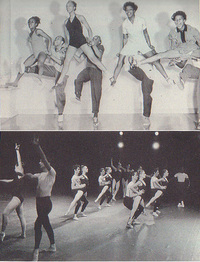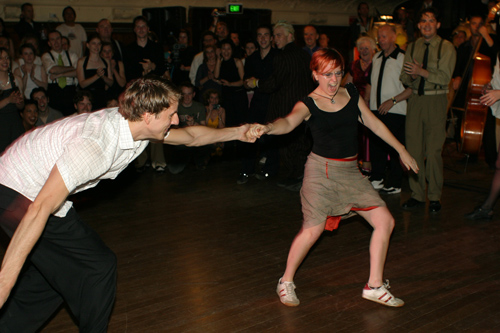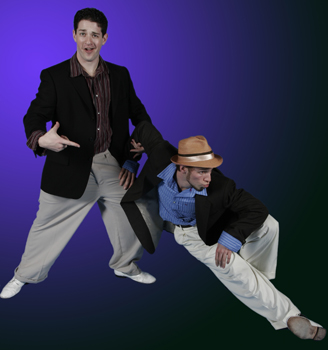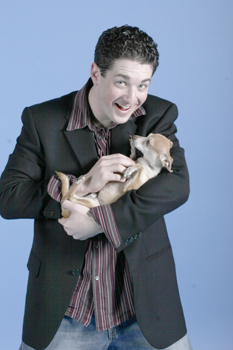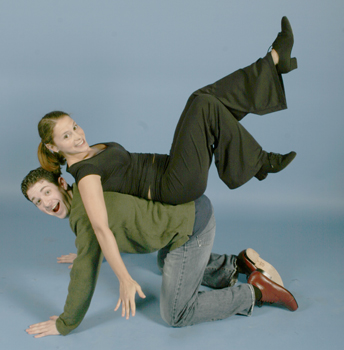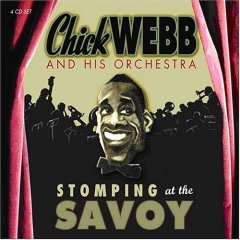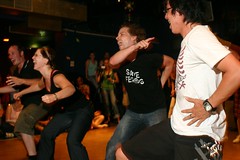I’m addressing some interesting points Brian raise in the comments to the unexpectedly entry from a couple entries ago.
Brian writes in that comment:
That of course leads on to the big question is: “Is playing a small amount of non-swing music at a swing event a major problem.†The smarty pants answer would be, just play some Neo. My real answer is I don’t know. What I to know is that to put a non-swing song in your set and for it to go down will with all the dancers takes a lot of skill. I find you must first make sure all the classic hard core dancers are happy and maybe even some of them left (gone outside) the room. Play some hardcore classic songs in a row of upper tempo and you should achieve this. Then it’s a matter is checking if those “non-swing mood group are in the room and ready to dance. You then need to make the transition and then comes the non-swing song. And hey the songs selection is like bringing a cat for a walk.
This section really interested me. That’s a really clever approach. I’d been thinking “there’s no way I’m every playing neo because I hate it”. But this scheme offers me a new approach. It reminds me of Trev’s comment here on Swing Talk where he says:
Yes, the ‘wave’!
I was using it last night (will post set soon) – although lately i’ve been more brutal with my tempo changes – it’s great for shaking things up, and avoids things “sounding all the same”.
Don’t be afraid to drop in a fast, high energy one when you have the floor full at medium. I’m not talking crazy fast, but something around 190-210bpm. The folks that are into it will be hanging out for it, and if you keep the tempos too low (to keep the floor full) they will get bored/lazy. Even if you only get 2 couples dancing to a fast song, you get the benefits of:
a) lifting the energy/enthusiasm of the room even if they don’t dance; b) inspiring others to get better go they can do it too. It’s not the same for everyone, but when I was new watching a high-energy dance motivated me to keep at;
c) sending people to the bar to spend their $ on the venue!
If you do it right, the room will be buzzing, and you can follow up with something at around 150 and everyone will be right back into it.
I generally wouldn’t play more that 2 fast tempo songs in a row. People start getting pissed if they don’t want to/can’t dance fast, and tired if they’ve been dancing to it.
(NB the setlist he’s referring to is here, though I’m not sure which setlist he means)). For a description of ‘the wave’ check out this thread on swingdjs.
… ok, so now to address the point.
Basically, both Trev and Brian are suggesting that the DJ use the ‘wave’ – which is a way of describing the general ‘flow’ of mood in the room, to provoke a particular response from dancers. It’s hard to explain how it works with dancers, but
I’ve just been reading some fascinating articles referring to David Seamon’s book A Geography of the Lifeworld where he describes exactly this phenomeon – people making a space ‘place’ by repeated actions and social interaction. So, everyday a man makes a coffee shop ‘place’ by rising at 8, walking to the coffee shop, buying a paper, ordering a poached egg and coffee, eating and reading til 9 when he walks on to work. The man comments that he is only made aware of how ‘comforting’ and ‘warm’ this cafe space is when the series of actions is interrupted by something like the paper being sold out.
Seamon talks about this as people becoming aware of their ‘precognitive’ behaviour only when it’s interrupted. In other words, he’s interested in what happens when people are made conscious of the stuff they do habitually in particular spaces to make those spaces a ‘place’.
This phenomenological stuff really makes me laugh, because they write like no one has ever thought to investigate what happens when you make people aware of their unconscous habits. When of course, any physiotherapist, yoga instructor or dance teacher spends all their working hours helping people develop a ‘body awareness’, where they become conscious of the things they do habitually with their bodies and muscles.
but anyway…
That theory seems particularly relevent to this discussion of DJing, because DJs are basically people who develop the skills to manipulate the mood of a room full of dancers so as to get them all dancing. I’ve been absolutely fascinated, as a noob DJ, by the way the choices I make in playing songs and combining songs can affect the mood of a crowded room. While, as a dancer, I respond unconsciously to the music, either getting really ‘high’ with uptempo, upenergy music, or getting really ‘low’, and moderating my dancing (my unconscious movements and social behaviour), as a DJ, I’ve had to become conscious of this process and figure out how it works.
It’s important to note that ‘precognitive’ behaviour is essential to skilled partner dancing. I’m frequently reminding myself ‘stop thinking!’ and ‘just follow!’. It’s like driving a manual car – you suddenly reach a point when you’re learning where the combination of accelerator, clutch, gear stick, etc becomes unconscious. And when you’re suddenly made conscious of this process, it often stuffs up.
Leading, however, can be more comfortably ‘cognitive’ than following as you are planning and determining the course of the dance. I have found, though, that the best dances, the most effective ones, where I really use my centre to move their centre, are the ones where I relax and ‘just move my body’ naturally, rather than ‘trying to lead’ in order to effect weight changes which in turn move the follow’s weight – effecting their weigh changes.
So when Trev talks about manipulating the wave (ie developing a ‘mood’ or ‘vibe’ in the room, or, to use Seamon’s approach, making a space ‘place’ through playing music which will provoke particular social responses through dance), Brian talks about exploiting the wave/dancers’ response to the wave to sneak in songs which are potentially going to ‘break’ the wave. So he plays ‘risky’ songs (like neo) after a couple of faster, old school swinging jazz traacks, so that he can exploit the old school fans’ taking time out for a break to slip in some neo. So the potential ‘risk’ of playing the neo stuff is ameliorated.
Trev also talks about ‘breaking’ the wave constructively by making quicker transitions between tempos – dropping in a fast one, even if the floor was full at slower tempos, then dropping the tempo down again to ‘recover’ and pick up the dancers who’ve stepped off the floor for that fast song. And, incidentally, giving those who danced the faster song a break.
This is fascinating shit, because it all reveals how important it is as a DJ to be a dancer, but perhaps more importantly, to consciously recognise how dancers respond to combinations of songs and musical moods to manipulate the mood of the room, but also to ‘please everyone’. I adore this approach because of the way it contrasts with the comment “you can’t please everyone” a DJ (whose work doesn’t impress me at all) said to me recently. This comment ‘you can’t please everyone’ seems (in the case of this DJ) to serve as justification for not attempting to work the room and ‘wave’. Or rather, to me it seems like this DJ made this comment because they are simply unaware of these issues. Which holds true with their dancing, where they are similarly ‘unaware’ of other dancers in the immediate vicinity, unable to ‘feel’ their partners’ weight changes, and have a propensity for rough leads.
In my own DJing, however, I’ve recently discovered that I can actually keep the floor full for the entire set, at a 100% strike rate. This usually means playing mid-tempo songs, and not taking any ‘risks’. Yet one of the results of this approach is that some of the dancers (mostly that hardcore, experienced group), while they’re dancing every song and enjoying themselves, really want me to play some faster songs as well.
I’ve been a bit tentative about doing this, as the numbers on the floor immediately drop when faster songs are played (though I have noticed that they pick up or don’t drop if the song is very swingy and good quality). One thing I have learnt, as Trev has pointed out, is that it’s ok to drop the numbers for a song or two. I’ve also found that if the floor does empty (for any reason, whether the song was fast, or you’ve played a dud) there are ways to fill it again – I have a few ‘safety songs’ which will always fill the floor. So it’s ok to play fast songs, empty the floor, and then fill it again. As Trev has pointed out, playing the odd faster song will, while people stand out for a song or too, actually pump up the energy in the room. And, as Brian points out, it also gives you an opportunity to play something that group of experienced, old school faster dancers wouldn’t dance to anyway, even if they weren’t standing on the sidelines strugging to breathe.
Another trick that Brian has noted before, is that if you do take the tempos up really high, you can actually raise the overall tempos when you play the next song. So if you find the room is stuck at about 140bpm, playing something at 200, while it may clear the room for those 3 minutes, will actually make it possible for you to follow up with something at 160 or 180, because it feels so much slower, comparatively, people get out there and dance. So allowing you to up the general tempo of the room, and change the overall wave.
I have noticed, however, that while you can raise the tempos generally, you will have to bring them down again eventually, as people’s energy and stamina wears out. I had previously been obsessed with getting tempos up and keeping there, as if 200bpm was my ultimate goal. Now I realise that it’s about varying tempos over the course of the night – the wave is a wave, and not just an incline. The trick is, of course, managing these crests and troughs without dropping the energy and tempos prematurely.
So DJing is a really interesting way of putting into practice that phenomenological approach to media use in everyday spaces.
NB when we say ‘bpm’, we mean ‘beats per minute’. The average speed of house or ‘dance’ music is 120bpm. The average tempo for dancing lindy in the 1930s was 180bpm. I can follow comfortably up to 180bpm, then I have to work harder. I can lead comfortably up to about 160. 20s Charleston, however, requires faster tempos – over 200 is average. Over 300 is ‘fast’. We can dance to such high tempos in lindy because the music ‘swings’ – it doesn’t feel like you’re rushing, and in fact really swinging songs feel slower than they are. Which helps to keep you relaxed, as you can’t dance fast if you’re freaking. 20s charleston, however, is usually danced to ‘dixie’ or jazz from the 20s, which predates swing, and has a different timing – 1-2, 1-2, 1-2 rather than 1-2-3-4, 5-6-7-8.
FYI: 180bpm is more than 3 steps per second, as we actually make 10 weight changes (or steps) in the basic lindy rhythm and Swing Out (fundamental step of lindy).


